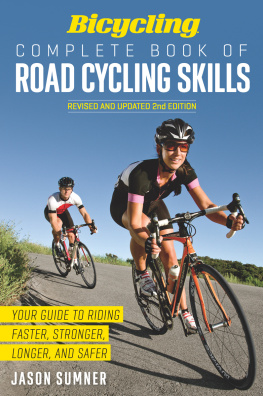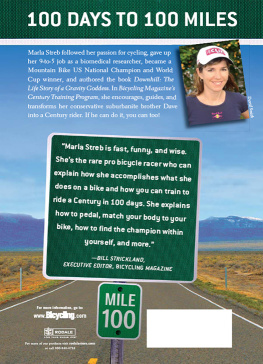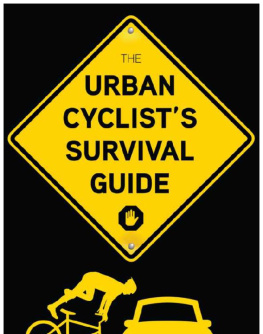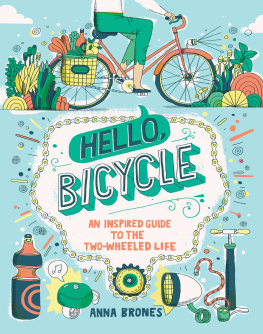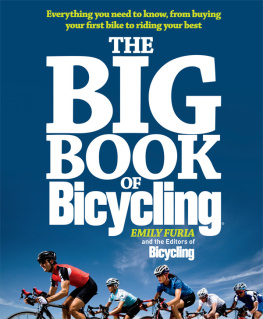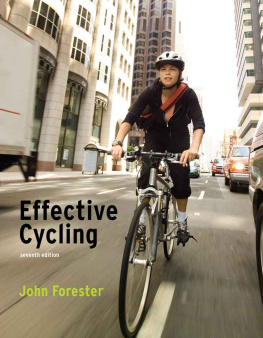About
the Author
Robert Hurst is a veteran bicycle messenger and all-around urban cyclist who has cycled more than 150,000 miles and 15,000 hours in heavy traffic. In this time, he has completed something like 80,000 deliveries. Robert is also the author of Mountain Biking Colorados San Juan Mountains: Durango and Telluride (FalconGuides) and Road Biking Colorados Front Range (FalconGuides).
acknowledgments
Although the gaffes and screwups in these pages are solely the responsibility of the author, who begs your pardon for them, the good stuff comes from many people.
Thanks first to the forward-thinking editors at Globe Pequot, Scott Adams and Dave Singleton, who showed great patience as they waited for me to finish this and that.
Deepest gratitude also to the incomparable Marla Streb for writing the foreword, and to Sam Turner for his illustrations.
Heartfelt thank-yous go to the several dozen urban cycling maniacs that I am blessed with knowing, many of whom are close friends. For years I watched them negotiate the city streets with style, grace, and intelligence. The cumulative riding experience among them is mind-boggling. The advice they give comes from millions of miles and a sprinkling of near-death experiences, and does not always correspond to the conventional wisdom. Especially among this group I must thank Robert Reid, Christie Martin, Mike McGranahan, Steve Campana, and Joe Dillon; their comments were instrumental in the books completion.
I received free help smoothing out the manuscript from Kamla Hurst and Steve Campana, and gave my dad, Jerry Hurst, a fat target for his grammatical acuity. (Dad is a retired high school English teacher.)
Sincere thanks to John Forester. Although much of what I say here is at odds with his instructions about riding in traffic, and this book in your hand is on some level an answer to his own books, that I feel so obliged to address his vehicular-cycling principle right away and then so often afterward is a testament to its power: vehicular cycling is a functional style that serves many cyclists very well. Forester is quick to point out that vehicular-style cycling is a very old style that came to the United States by way of England in the 1930s, but the articulation of the vehicular-cycling principle was an original Forester project, and he has been defending it (with gusto) for more than a quarter century. And you wont have to look too hard to find loads of statistics and ideas that I, like many other cyclists, first came across in Foresters books, Effective Cycling and Bicycle Transportation: A Handbook for Cycling Transportation Engineers. These stats are referred to copiously herein, an example of how the same numbers can support different conclusions.
Jobst Brandt, author of a guide that hopeless bikeophiles call The Book (The Bicycle Wheel), cheerfully skewered my section on tire wiping, and his presence in these pages lends a brief flash of wisdom, and I am grateful for that.
Finally, thanks to all the cyclists out there who ride every day, snow or shine, in a way that makes it easier for others to do the same.
bibliography
Allen, Frederick Lewis. The Big Change. New York: Bantam Books, 1952.
Allen, John. Street Smarts. Emmaus, Pa.: Rodale Press, 1988.
Berkow, Robert, M.D., Mark H. Beers M.D., and Andrew J. Fletcher editors, The Merck Manual of Medical Information. Whitehouse Station, N.J.: Merck and Co. Inc., 1997
Blake, Peter. The Master Builders. New York: Alfred A. Knopf, 1960.
Blewett, Stephen, and Mary Embree. Whats in the Air. Ventura, Calif.: Seaview Publishing, 1998.
Bottles, Scott. L.A. and the Automobile. Berkely: University of California Press, 1987.
Brandt, Jobst. The Bicycle Wheel. Menlo Park: Avocet, 1981.
Brilliant, Ashleigh. The Great Car Craze. Santa Barbara: Woodbridge Press, 1989.
Burke, Ed. Serious Cycling. Champaign, Ill.: Human Kinetics, 2002.
Campbell, Colin. The Coming Oil Crisis. Brentwood: Multi-Science Publishing Company, 1997.
Cherry, Richard. EMT-Basic Exam Review. Upper Saddle River, N.J.: Prentice Hall, 1999.
Davis, Mike. City of Quartz: Excavating the Future in Los Angeles. New York: Vintage, 1992.
Dodge, Pryor. The Bicycle. Paris: Flammerion, 1996.
Doyle, Jack. Taken for a Ride. New York: Four Walls Eight Windows, 2000.
Flink, James. The Automobile Age. Cambridge: MIT Press, 1988.
Ford, Larry. The Spaces Between Buildings. Baltimore: Johns Hopkins University Press, 2000.
Forester, John. Bicycle Transportation: A Handbook for Cycling Transportation Engineers. Cambridge: MIT Press, 1994.
. Effective Cycling. Cambridge: MIT Press, 1984.
Garreau, Joel. Edge City. New York: Doubleday, 1991.
Gleick, James. Chaos. New York: Penguin, 1987.
Hugo-Brunt, Michael. The History of City Planning. Montreal: Harvest House, Ltd., 1972.
Jackson, Kenneth. Crabgrass Frontier. New York: Oxford University Press, 1985.
Jacobs, Jane. The Death and Life of Great American Cities. New York: Random House, 1961.
Johnson, Steven. Emergence. New York: Scribner and Sons, 2001.
Koolhaas, Rem. S, M, L, XL. New York: The Monacelli Press, 1994.
. The Lang Emergency. New York: The Atlantic Monthly Press, 2005.
Kunstler, James Howard. The City in Mind: Meditations on the Urban Condition. New York: Free Press, 2001.
. Geography of Nowhere. New York: Simon and Schuster, 1993.
Lacey, Robert. Ford: The Men and the Machine. Boston: Little, Brown and Company, 1986.
Le Corbusier. The City of Tomorrow and Its Planning. London: J. Rodker, 1929.
Marshall, Alex. How Cities Work. Austin: University of Texas Press, 2001.
McGurn, James. On Your Bicycle: An Illustrated History of Cycling. New York: Facts On File Publications, 1987.
McShane, Clay. Down the Asphalt Path. New York: Columbia University Press, 1995.
Mumford, Lewis. The City in History. New York: Harcourt, Brace and World, 1968.
Nye, Peter. Hearts of Lions. New York: W. W. Norton & Company, 1988.
Rae, John B. The Road and the Car in American Life. Cambridge: MIT Press, 1971.
Reti, Ladislau, ed. The Unknown Leonardo. New York: McGraw-Hill Book Company, 1974.
Robinson, Bruce. Is There Any Reliable Evidence That Australian Helmet Legislation Works? Proceedings of Velo Australia. Fremantle, Australia, October 30, 1996.
Rowland Whitt, Frank, and David Wilson. Bicycling Science. Cambridge: MIT Press, 1982.
Safdie, Moshe. The City After the Automobile. New York: Harper-Collins, 1997.
Schwela, Dietrich, and Olivier Zali, eds. Urban Traffic Pollution. London: E & FN Spon, 1998.
Scuffham, Paul, and John Langley. Trends in Cycle Injuries in New Zealand Under Voluntary Helmet Use. In Accident Analysis and Prevention. Vol. 29, no. 1 (1997).
Smith, Robert. A Social History of the Bicycle. New York: McGraw-Hill, 1972.
Thompson, D. C., F. P. Rivara, and R. S. Thompson. Effectiveness of Bicycle Safety Helmets in Preventing Head Injuries: A Case Control Study. In JAMA. Vol. 276, (1996): pp. 196873.
Walden, Russell, ed. The Open Hand: Essays on Le Corbusier. Cambridge: MIT Press, 1977.
Watson, Ann, Richard Bates, and Donald Kennedy, eds. Air Pollution, the Automobile, and Public Health. Washington, D.C.: National Academy Press, 1988.
Wilson, James Q., ed. The Metropolitan Enigma. New York: Doubleday, 1968.
Yang, Nai C.


